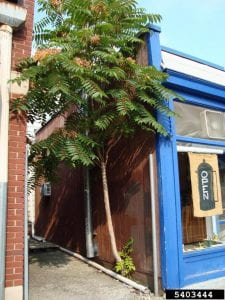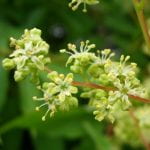By Cecille Jones, Monroe Master Gardener Volunteer
This article appeared in the March 2021 Issue of Gardening in Orange County.
 When you hear the name tree-of-heaven (Ailanthus altissima), remember this: There is nothing heavenly about this invasive plant. It is so named only because it can grow to such heights that it is as if it’s reaching for the sky.
When you hear the name tree-of-heaven (Ailanthus altissima), remember this: There is nothing heavenly about this invasive plant. It is so named only because it can grow to such heights that it is as if it’s reaching for the sky.
This plant is aggressive and does not have natural predators to keep it in check. When native plant and animal species are hindered, the balance and biodiversity of the native ecosystem is upset and could potentially lead to extinctions.
 Also called Chinese sumac, the tree of heaven is attractive to pollinators, further ensuring its spread. It releases a toxic chemical into the soil that harms other plants, rodents and microbes. What’s more, the tree-of-heaven is said to advance the spread of the spotted lanternfly, an invasive insect that feeds on and damages many species of native and fruit-bearing trees. The lanternfly prefers to lay its eggs on the tree-of-heaven, so keeping this tree in check could limit the lanternfly’s advance.
Also called Chinese sumac, the tree of heaven is attractive to pollinators, further ensuring its spread. It releases a toxic chemical into the soil that harms other plants, rodents and microbes. What’s more, the tree-of-heaven is said to advance the spread of the spotted lanternfly, an invasive insect that feeds on and damages many species of native and fruit-bearing trees. The lanternfly prefers to lay its eggs on the tree-of-heaven, so keeping this tree in check could limit the lanternfly’s advance.
Identification
Proper identification of the tree-of-heaven is important because it can be confused with native plants such as the staghorn sumac, black walnut and butternut, to name a few.
One quick way to tell the difference: When you crush the foliage or break a twig, the tree-of-heaven will emit a foul odor.
 Like its native look-alikes, the leaves of the tree-of-heaven are pinnately compound. They have a central stem (called rachis) in which leaflets are attached directly opposite each other. One leaf can be as long as 4 feet with 10 to 40 lance-shaped leaflets with smooth margins, except at the base where there are one of two protruding bumps called grandular teeth. In contrast, the leaves of the native plants are much shorter and have fewer leaflets with serrated (teeth-like) margins.
Like its native look-alikes, the leaves of the tree-of-heaven are pinnately compound. They have a central stem (called rachis) in which leaflets are attached directly opposite each other. One leaf can be as long as 4 feet with 10 to 40 lance-shaped leaflets with smooth margins, except at the base where there are one of two protruding bumps called grandular teeth. In contrast, the leaves of the native plants are much shorter and have fewer leaflets with serrated (teeth-like) margins.
Management
Tree-of-Heaven is a formidable advisory as it spreads using both seeds and root sprouts. Cutting down of tree-of-heaven is ineffective and may exacerbate the problem as the remaining roots will then send up new sprouts. Watch this great video to learn how to effectively remove tree-of-heaven from your property.
Pesticide regulations vary state to state. If unsure whether or not you can use a certain pesticide in your state, contact your local Cooperative Extension Office. When using herbicides make sure to carefully read the entire label before application and follow all of the instructions including wearing proper personal protective equipment (PPE). The label is the law!
Resources
Tree-of-Heaven – Lower Hudson Prism
Managing Invasive Plants: Methods of Control – University of New Hampshire
Tree-of-Heaven – Penn State Extension
